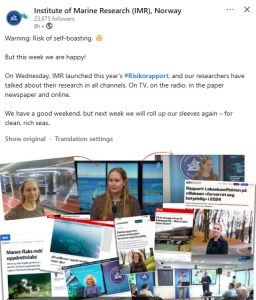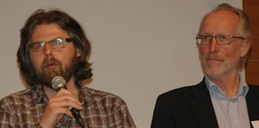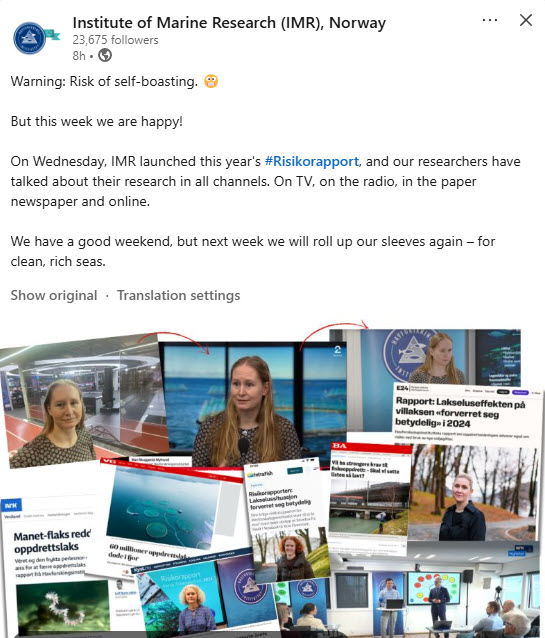High risk: This week the Institute of Marine Research posted that there was a high risk of self-boasting within IMR. This is because they have been speaking to the media about the risks of salmon farming in Norwegian fjords without any hard evidence to support their claims.

IMR have got it wrong, as they have the science. There is certainly a much bigger risk of this self-congratulation than there is risk to wild salmon.
2019: My attention was recently drawn to another commentary from Aquablogg, but this time from 2019. It might be six years old, but it is as relevant now as it was then. It concerned a chapter of a book about conflicts of interest in research written by Norunn Myklebust, the director of the Norwegian Institute for Nature Research (NINA). Her chapter is titled ‘… so corrupt that I have no words…..’ and subtitled ‘Incitement and harassment in research’. Aquablogg writes ‘Should researchers be protected from annoying questions?’
According to Aquablogg, “Norunn Myklebust portrays NINA researchers as the victims of critical industry players, whilst the reality it is that these researchers who hold the power, since they are the ones who give management advice to the authorities, without reference to those who are affected by such advice. They have also ensured that the future of the aquaculture industry is being dictated by the demands of the wild fish sector. This has not only cost, and will cost, the aquaculture industry many billions of kroner but more importantly has undermined the health and welfare of farmed salmon. The responsibility Aquablogg concludes, lies with NINA and other institutes who have incorrectly concluded that salmon farming is the cause of the problems for wild salmon”. But what is most critical is that the policies recommended to safeguard the future of wild salmon have failed miserably.
Aquablogg says that “Myklebust turns reality upside down. It is the researchers who have usurped the power to define the current topics: lice and escaped farmed salmon. Research dissemination involves the researchers traveling around to propaganda meetings where they conjure up statistics to fool lay people into believing that they are describing actual conditions. The researchers allow themselves to be interviewed by uninformed journalists who willingly pass on the story of the end of wild salmon. During the years 2008- 2010, researchers and managers usurped control over public opinion about the farming industry as an environmental disaster, strongly supported by the bureaucrats in the Norwegian Environment Agency”.
The blog continues that “the fight for control over the narrative about the aquaculture industry was, among other things, about conquering and allocating positions as victim, problem solver, top researcher and ruthless occupier of the commons. It is about the fight between the bad and the good. Money is, as is well known, the totem of evil, and care for nature and the environment is the totem of good”.
Jan Gjovik who writes Aquablogg provides an example of how NINA researchers responded when he was invited to make a presentation at a seminar at Hardangerfjord/ Jan says “he was invited to be the whipping boy who would argue against NINA’s science and NINA researcher Torbjørn Forseth was the one who would swing the whip. Dr Forseth spent 70% of the time presenting his CV, and the rest of the time pointing out that Jan had not got one so his criticism of NINA’s research could therefore not be taken seriously”.
There are always two sides to a debate and thus it was interesting to come across an article in Kyst.no from 17th March 2018 written by Kari Tveite which reports on the seminar. (This is a direct translation). There also seems to be discrepancy about the date that this meeting took place as Aquablogg states a date some years earlier. Regardless of date the article reads:
“At the recent Hardangerfjord seminar. Jan Arne Gjøvik and Trorbjørn Forseth were tasked with answering the question as to the extent to which Norwegian salmon management is governed by biased research. This proved to be the most emotional part of this year’s seminar.
Consultant Jan Arve Gjøvik believes that the research focus on the impacts of escapes and salmon lice in wild salmon is wrong, and he believes it may be difficult to find the actual reasons for wild salmon’s problems if the focus remains unchanged.

Senior researcher Torbjørn Forseth at the Norwegian Institute for Natural Research (NINA) and head of the Scientific Council for Salmon Management, believes that scientific debate is necessary for professional progression but in his opinion, the debate should take place primarily in scientific journals.
Wrong focus hinders problem understanding
Jan Arve Gjøvik was first to speak and gave a quick but comprehensive presentation of why he believed it was wrong to assume that salmon lice and escapes were the cause of the wild salmon’s problems.
– I think this creates the wrong focus in the debate, which in turn prevents us from finding the actual causes, and with them the concrete solutions to the problem, Gjøvik told the seminar.
Among other things, he questioned whether the blinkered focus on sea lice and escapes as the most important causes behind the problems of wild salmon is causing delays in the search for facts. He also suggested that it could be argued that the blinkered research is just being used as an excuse for not wanting to know.
Presented publication lists and CV
Torbjørn Forseth in Nina answered the question of the extent to which Norwegian salmon management is governed by biased research by referring to publication lists for international scientific research and his own CV.
“I’m not doing this to brag about myself, but to show that I am professionally trained to do this,” the senior researcher told the audience.
Several people who have done research on the ocean
According to Forseth, there are several people who have researched how wild salmon fare during the period they spend in the ocean, but he emphasized that it is wrong to say that Jens Christian Holst, formerly of the Institute of Marine Research has invented this research. He pointed out, that Audun Rikardsen at the University of Tromsø is perhaps the one who has shown us the newest things about salmon in the ocean in the last 10 years.
Must get on the publication path
Forseth was clearly irritated by what he described as attacks with a quasi-scientific approach, and he would like prefer that Gjøvik should publish his research in international publications.
– Using numbers the way Gjøvik does is not a solution. The truth in the salmon debate with Gjøvik and others is that they are marginalized. You will not find any Minister of Fisheries and Coastal Affairs who refers to Gjøvik work, Forseth told the audience at the Hardangerfjord Seminar.
Engaged debate
In the debate following the two presentations, Gjøvik emphasized that the figures he used in his presentation were taken from the national sea lice surveillance.
Torbjørn Forseth, for his part, wanted to downplay what was stated in Gjøvik’s introduction by saying that he hardly has support from the aquaculture industry, and certainly not from politicians.
In comments from the audience, it was emphasized that debate is important, and that researchers should debate more publicly. But Forseth responded by expressing that he hoped to avoid spending time and energy on arguing. He said dialogue meetings are good, but he does not think Gjøvik has anything to contribute.”
It is interesting that Dr Forseth stresses the importance of published research because last year Solveig van Ness, Albert Imsland, and Simon Jones published a paper in Reviews in Aquaculture which claimed that the Traffic Light System overestimates the effect of sea lice, yet rather than engage in a scientific discussion or counter the paper with a different interpretation of the data, Mari Myksvoll (Research Manager Environmental Effects of Aquaculture), Ørjan Karlsen (Scientist sand Project Manager for Sea Lice ) and Geir Lasse Taranger (Research Director Aquaculture, Environment, and Technology ) all from the Institute of Marine Research responded in a newspaper article in E24. They said that the assessments made in the new paper do not represent the professional consensus within the field. What they mean is the new paper does not agree with their view and as they believe that their view is right, anyone else’s view, whether it appears in a scientific publication or not, can simply be ignored.
According to Aquablogg, Norunn Myklebust has said that NINA will not consider the science promoted within the Aquablogg commentaries because she considers the criticism unfair, yet Aquablogg points out that she should not be surprised that those who are met with silence will sometimes resort to non-traditional methods to argue the science.
By coincidence I will share one example. I have previously posted an image of a graph showing catches of salmon from rivers on the west coast of Scotland compared to those from rivers the east coast. This graph was generated from the official catch data published by the Scottish Government. This data is publicly available and anyone, not just scientists, can use the data to draw the exact same graph. The trendline is added using Excel and not by calculation.
I recently sent this graph to twenty scientists who work on sea lice or are members of the Scientific Committee of Salmon Management and asked if they could explain why the rate of decline from both coasts is identical and if sea lice are to blame for the decline in the west, then what is causing the identical decline in the east. This should not be a difficult question for such experts to answer. I also identified myself as a scientist to differentiate myself from the lay people, that Norunn Myklebust prefers not to engage with.
Of the twenty mails, I received the total of one reply. Nineteen of these experts preferred to ignore my question, presumably because it doesn’t fit in with their views and/or they simply cannot answer the question. One of those sent the mail was Norunn Myklebust and she was not the one who replied.
The only reply did not offer any suggestion as to what might cause the similar rate of decline between salmon farming and non-salmon farming areas. It was then mentioned that their knowledge of Scottish salmon was poor.
It was then suggested that I should take a more direct effort and gather knowledge about factors that affect smolt production, quality, run timing, and smolt sizes. I was then advised to consider angling effort, spawning biomass, age of the fish etc. Scottish Government scientists and the fisheries management sector have been collecting such information for years and none of them have been able to suggest why the rate of decline is similar across all of Scotland.
It was then suggested that a better approach is to single out rivers in the farm intensive side and compare survival of the salmon run with farming activity between years as was done for the Erriff. I was supplied with a link to the relevant paper, except it was a paper about the negative impact of sea lice on recreational angling catches in Norway and not the Erriff.
Interestingly, this researcher appeared unaware of the latest science from Ireland that debunks the claims made that salmon farming has had a negative impact on catches from the Erriff.
Another approach was also suggested which is to conduct smolt return experiments using protected smolts. This is an interesting idea since the biggest such experiment published in 2013 by Jackson et al was highly criticised by a researcher from NINA, presumably because eth experiment found a mortality level of around 1% which was massively lower than (wrongly) claimed by the established scientific consensus.
The reply ended by suggesting that there is a general decline in salmon populations due to altered marine survival, which the reply says is linked to environmental changes. However, the decline of Scottish salmon goes back to 1970 which was before salmon farming and before climate change was highlighted as an issue.
A reply to these suggestions was sent to which there has been silence.
Returning to Aquablogg which says that “the process that has led to sea lice and escaped farmed salmon gaining status as an important environmental problem can be interpreted as the result of collusion between researchers and managers with an agenda. It is not a malicious intention to “take on” the farming industry that is at the root of it. Rather, the lofty, shining goal of saving wild salmon and the natural environment is the driving force, as the researchers themselves experience it. The problem is not dishonesty, falsification or fabrication of data”.
The commentary continues that “the problem is that this research is conducted in echo chambers where everyone believes the same thing. What is reprehensible is the united desire to provide further evidence for the prevailing theory and the unwillingness to listen to alternative views. This can lead to selective selection of data and to choosing an unsuitable statistical method that makes the results significant”.
What is not of any surprise is that this whole scenario is also being played out in Scotland. Anglers have long blamed salmon farming for the decline of wild salmon and Scottish Government scientists, some of whom were avid anglers themselves, especially in the earlier days, The former head of the Pitlochry Lab has clearly expressed his view on salmon farming in his memoir – ‘The Longshoreman ‘and he was also responsible for recruiting scientists who were sympathetic to his view. Their resulting science formed the basis of the advice given to Scottish Ministers and equally why, like their Norwegian counterparts, they have adopted a policy of silence.
Legal case: Intrafish recently reported that owners on the Gaula rivers are preparing a lawsuit against the salmon farming industry who they blame for the historic collapse of wild salmon. The Gaula River Owners Association have said that everyone who owns shares in salmon farming companies should sell out as soon as possible because shares will be squeezed if ‘we’ win the case against an industry that has proven to have major negative impact on wild salmon.
This illustrates the point that models are not evidence of a link between salmon farming and wild salmon declines. Even the establishment sea lice clique does not have any hard evidence of a link between the two. This case simply shows that the river owners have a lack of understanding of what is happening to wild salmon, except that there are none there for them to catch and kill
My advice to the Gaula River Owners Association is to bring this lawsuit to court as soon as possible. This will provide a real opportunity to challenge the Norwegian scientific clique to come up with the hard evidence required to support the river owners. Meanwhile, the salmon farming industry can now show that the scientific advice on wild salmon and salmon farming is wrong. This could have been easily resolved years ago if only these scientists would come down from their ivory towers and engage with the industry and their specialists.

